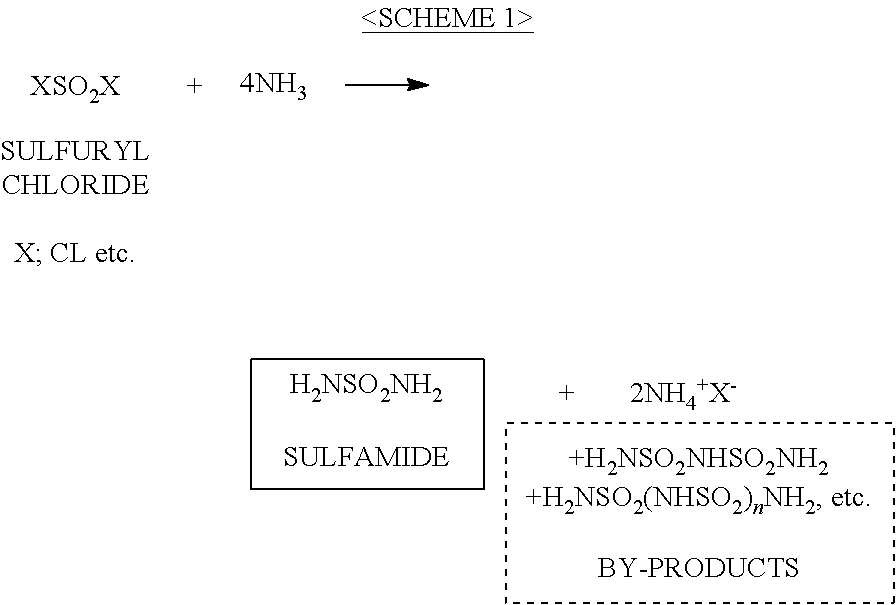Method for producing imidic acid salt
a technology of imidic acid salt and chlorosulfonylisocyanate, which is applied in the direction of organic compounds/hydrides/coordination complex catalysts, physical/chemical process catalysts, phosphorus halides/oxyhalides, etc., can solve the disadvantage of using relatively expensive chlorosulfonylisocyanate (clsosub>2), difficult to adopt industrial production methods of patent publication 1, and disadvantages of applying these methods to industrial mass production
- Summary
- Abstract
- Description
- Claims
- Application Information
AI Technical Summary
Benefits of technology
Problems solved by technology
Method used
Image
Examples
example 1
[0066]A 1 L autoclave was charged with 600 g of acetonitrile and 143 g (2.46 mol) of potassium fluoride and then cooled to 5° C. with ice water, followed by introducing 133 g (1.30 mol) of sulfuryl fluoride. Subsequently, 10 g (0.59 mol) of anhydrous ammonia was introduced over one hour. The reactor was increased in temperature to 60° C., upon which the reaction was brought into termination. A reaction liquid was filtered and a solvent was distilled out thereof, thereby obtaining 113 g of a crude bisfluorosulfonylimide potassium salt. The crude compound was recrystallized with ethanol thereby obtaining 90.5 g of potassium bisfluorosulfonylimide having a purity of 99% or more. The yield was 70%.
example 2
[0067]A 1 L autoclave was charged with 500 g of acetonitrile and 74.7 g (492 mmol) of cesium fluoride and then cooled to 5° C. with ice water, followed by introducing 26.6 g (260 mmol) of sulfuryl fluoride. Subsequently, 2.0 g (120 mmol) of anhydrous ammonia was introduced over one hour. The reactor was increased in temperature to 60° C., upon which the reaction was brought into termination. A reaction liquid was filtered and a solvent was distilled out thereof, thereby obtaining 36.5 g of a crude bisfluorosulfonylimide cesium salt. The crude compound was recrystallized with ethanol thereby obtaining 24.4 g of bisfluorosulfonylimide cesium salt having a purity of 99% or more. The yield was 65%.
example 3
[0068]A 1 L autoclave was charged with 650 g of acetonitrile and 209 g (3.60 mol) of potassium fluoride and then cooled to 5° C. with ice water, followed by introducing 155 g (1.56 mol) of phosphoryl trifluoride. Subsequently, 10.4 g (0.61 mol) of anhydrous ammonia was introduced over one hour. The reactor was increased to room temperature, upon which the reaction was brought into termination. The production ratio of this reaction was such that production of bis(difluorophosphoryl)imide was 100%, while production of F2P(═O)NPF(═O)NP(═O)F2 was not confirmed.
PUM
| Property | Measurement | Unit |
|---|---|---|
| temperature | aaaaa | aaaaa |
| Temperatures | aaaaa | aaaaa |
| Temperatures | aaaaa | aaaaa |
Abstract
Description
Claims
Application Information
 Login to View More
Login to View More - R&D
- Intellectual Property
- Life Sciences
- Materials
- Tech Scout
- Unparalleled Data Quality
- Higher Quality Content
- 60% Fewer Hallucinations
Browse by: Latest US Patents, China's latest patents, Technical Efficacy Thesaurus, Application Domain, Technology Topic, Popular Technical Reports.
© 2025 PatSnap. All rights reserved.Legal|Privacy policy|Modern Slavery Act Transparency Statement|Sitemap|About US| Contact US: help@patsnap.com



